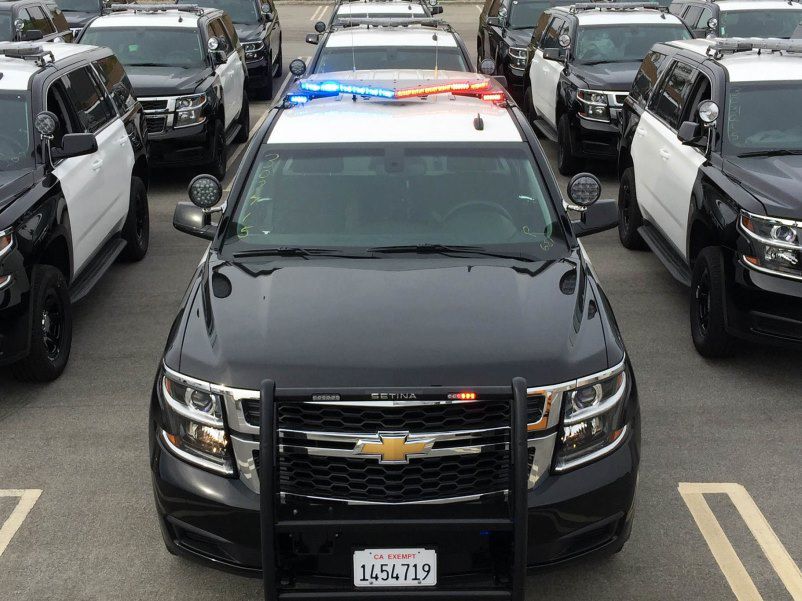Recent Articles
Popular Makes
Body Types
2015 Chevrolet Tahoe Police Pursuit Vehicle Review
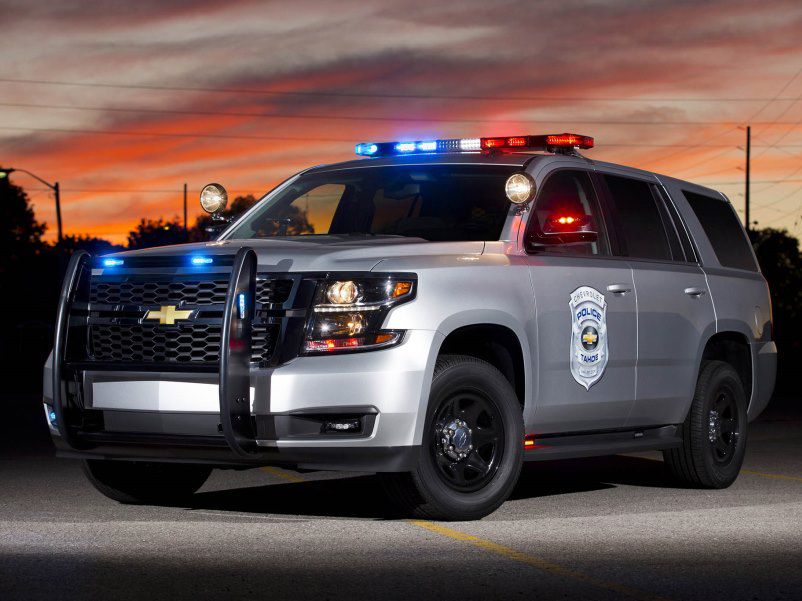
2015ChevroletTahoePolicePursuitVehicle1
Channeling my inner law enforcement persona, I asked Chevrolet if it would allow me to drive its updated 2015 Tahoe Police Pursuit Vehicle (PPV). I expected to be handed the keys to a full-blown police cruiser, a black and white complete with sirens and strobe lights, but instead a nondescript silver SUV with black steel wheels was deposited in my driveway. I was honestly a bit disappointed – until I realized it was mechanically all cop.
General Motors, like many other automakers, sells modified versions of its civilian vehicles for commercial duty. While some end up stripped, gutted and essentially de-contented for a service life of hauling flowers, lumber or frozen fish, vehicles headed to police duty are upgraded for a service life of reining in bad guys between ensuring security at donut shops.
Under the Hood
Mechanical upgrades for the 2015 Tahoe PPV begin with a new EcoTec3 5.3-liter V8 (L83) mated to a Hydra-Matic 6L80 6-speed automatic transmission. The powerplant, which is rated at 355 horsepower and 383 pound-feet of torque, is identical to civilian issue, but it’s augmented by heavy-duty oil and transmission coolers and a standard automatic locking rear differential (with the 3.08 rear axle ratio). And for the first time the Tahoe PPV is offered with 4WD featuring an electronically controlled transfer case.
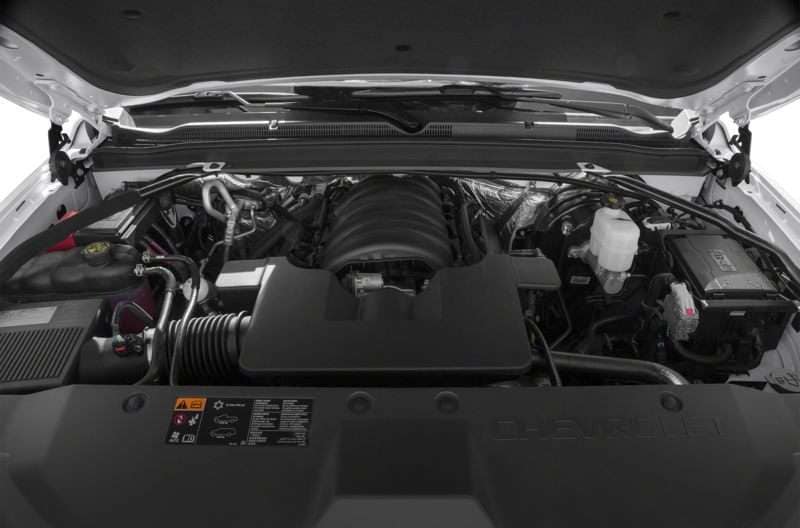
Heavy Duty Suspension
The PPV’s chassis rides on a modified heavy-duty suspension with stiffer springs, firmer shocks and jounce bumpers. A lower ride height improves high-speed stability, and a skid plate package protects the oil pan and other vital components from damage.
Standard civilian Tahoe models ride on 18-inch to 22-inch alloy wheels, which look great at the valet but don’t hold up very well when jumping curbs at speed. The police version arrives with 17-inch steel wheels wrapped in P265/60R17 Goodyear RSA rubber. The PPV also gets StabiliTrak electronic stability control with proactive roll avoidance, traction control, hill start assist, and high-temp front brake pads. Other mechanical goodies include a 26-gallon fuel tank, 170-amp alternator, 660 CCA battery with run-down protection, and a 730 CCA auxiliary battery.
With the exception of the glossy black wheels, most of the mechanical upgrades are discreetly hidden from view. That isn’t the case with the modified interior.
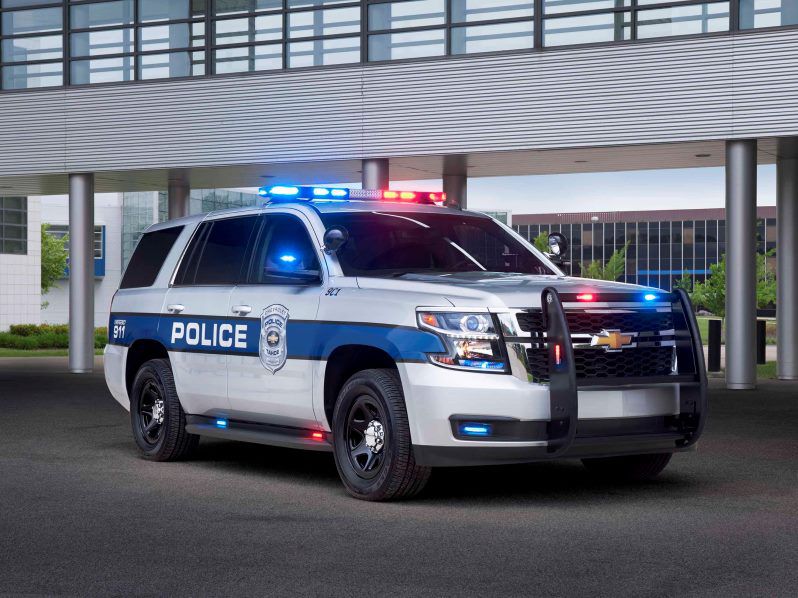
Inside the Cabin
Functional best describes the spartan cabin of the PPV. Leather and carpet are replaced by vinyl and cloth, materials easier to clean and more resistant to abuse. The two front seats are firm, cloth-covered buckets, but passengers in the second row (aka perps) luxuriate on sticky vinyl. The floor is industrial-grade rubberized vinyl, which in execution isn’t half as bad as it sounds.
The instrument panel is “straightforward,” says GM. The mostly analog gauges include a calibrated 150-mph speedometer, and a hard-to-read 4.2-inch driver information display is in the center of the cluster. It earns a D-grade in terms of ergonomics. The civilian overhead reading lights are supplemented by an old-school, round dome light with a toggle that switches between white or red illumination (to help preserve an officer’s night vision).
In addition to a long list of standard features (including a rear-vision camera, cruise control, and dual air conditioning), my test car had a driver-side halogen spot lamp, automatic headlight delete, and the optional Driver Alert package with forward collision alert, lane departure warning, safety alert seat, and power-adjustable pedals.
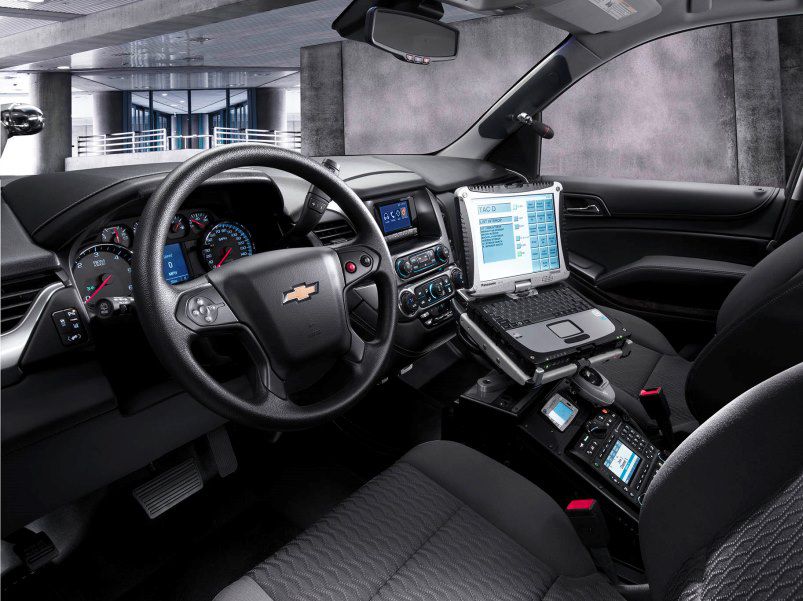
Driving Impressions
Unlike today’s civilian cars, the engine of the PPV starts without depressing the brake pedal – a throwback to an era before unintended acceleration litigation. The engine and exhaust are stock, but I sensed a bit more growl from the powertrain during idle. Maybe the V8’s more audible voice can be attributed to the lack of sound-absorbing upholstery in the cabin?
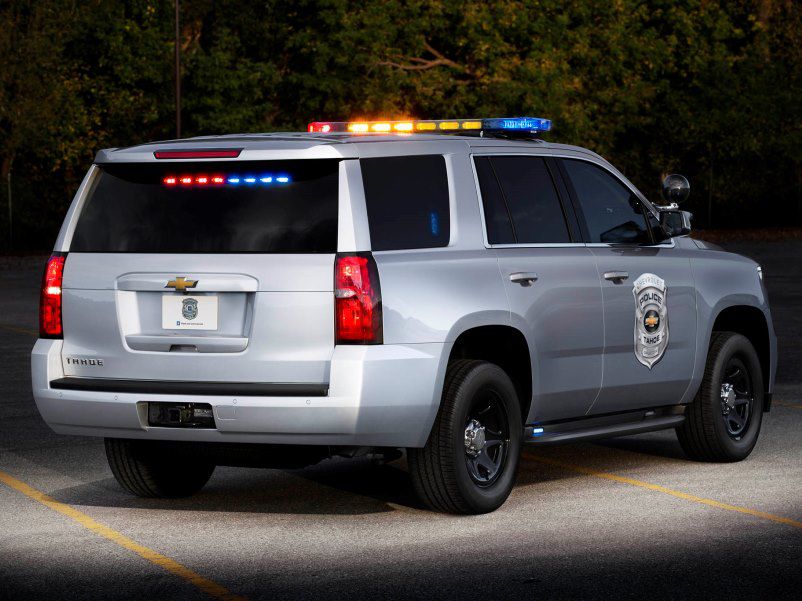
Acceleration
Acceleration is on par with standard Tahoe models, which means it will spin its rear tires without much effort (figure about 7 seconds to 60 mph, if you need a number), but off-the-line speed isn’t the PPV’s strength. Its athletic ability emerges in the corners, where its upgraded suspension, bolted to a rigid, fully boxed perimeter frame, transforms the somewhat clumsy stock Tahoe into a surprisingly agile player. I’m not saying that this 5,400-pound SUV is going to tail a Corvette around Road Atlanta, but it will give about 80 percent of the vehicles on the road today a run for the money in a congested urban environment – hands down it is the best-handling Tahoe/Suburban I have ever driven.
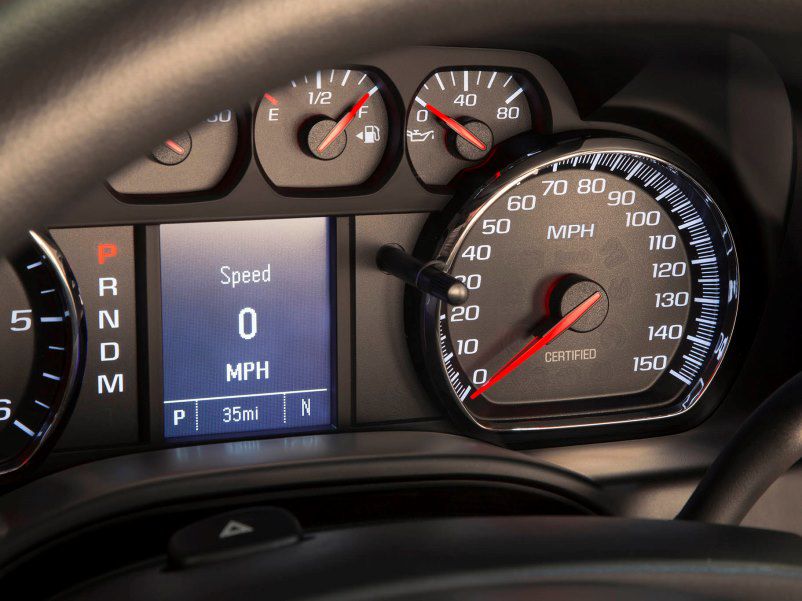
Chassis
The shocks, springs, wheels, tires and lower ride height work as a cohesive team to make the PPV feel downright agile. Turn-in is surprisingly quick, and the chassis doesn’t wallow or bounce unnecessarily following rapid steering inputs. Even though the new electric variable-assist power steering system is a bit numb, I quickly got the feeling that this SUV could autocross a challenging network of orange cones at speed without knocking over a single one – okay, maybe one or two.
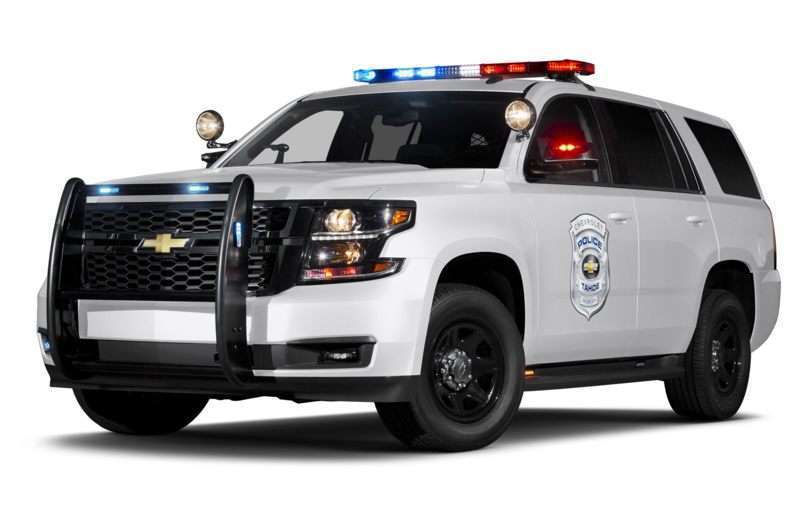
Braking
Braking is also improved thanks to the buttoned-down chassis. The upgraded heavy-duty brake pads are noisier than stock (they squeaked incessantly at low speeds), but their initial bite is excellent, and pedal feel is nearly perfect. They truly inspire confidence: I made a panic stop from 50 mph when an errant driver unexpectedly executed a U-turn in front of me, and I credit the brakes with saving, at the very least, the Chevrolet’s front bumper and grille.
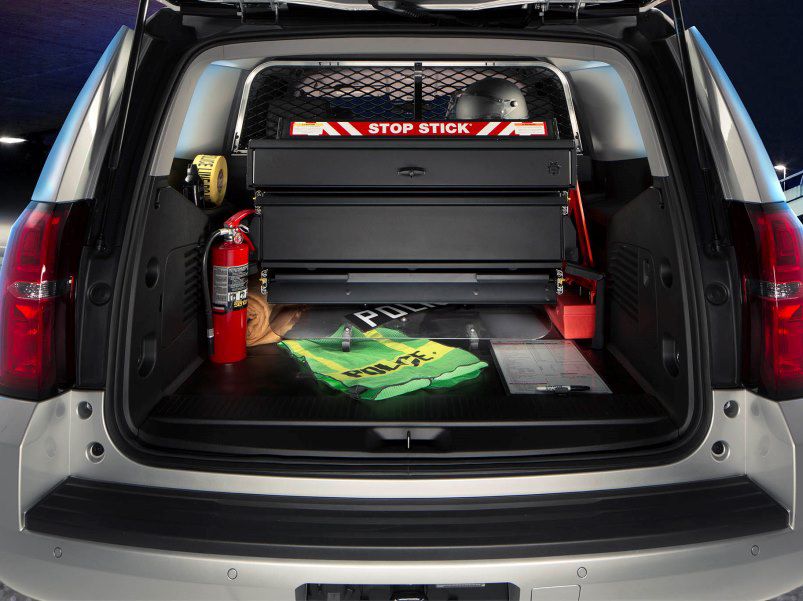
Ride Quality
As expected, the downside to this eye-opening agility is ride quality. The firm springs and dampers remove the words “plush” and “floaty” from the Tahoe’s (civilian) vocabulary and substitute “harsh” and “firm” in their place. The big SUV is not comfortable on anything but the smoothest road – every passenger who rode inside its cabin complained about the ride – and I found myself deliberately steering around manholes and bumps. (In its defense, my test vehicle was absent about 500 pounds of police equipment and gear, the additional mass that would likely help dampen the ride.)
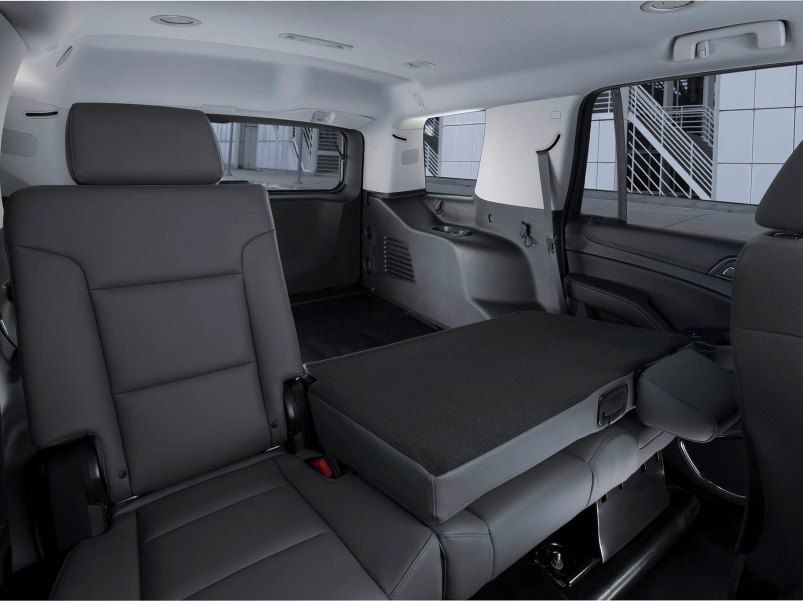
The Final Verdict
Despite evoking memories of certain painful infractions, the Tahoe PPV created quite a positive impression (though the kid in me would have preferred to see it wrapped with the feared black and white colors and capped by the loathed red and blue lights). I expected to be driving an overweight Chevrolet suv, burdened with half a ton of law enforcement equipment, that yawed like a yacht on sloppy seas, smoked its overworked brakes, and sucked unleaded faster than a cop at a quick coffee stop. Instead, I enjoyed a very capable purpose-built truck with excellent handling, track-level stopping ability, and surprising fuel economy (in the low 20s during its stay), each a very pleasant surprise.
And now that I’ve gotten a close look at those minimal second-row accommodations and experienced the stiffer-than-a-desk-sergeant’s-neck ride, I’m more determined than ever to avoid any infraction that might put me in the back seat of a Tahoe PPV cruiser!
